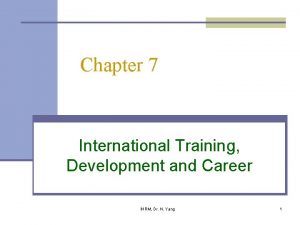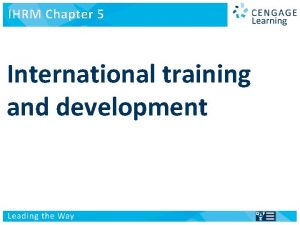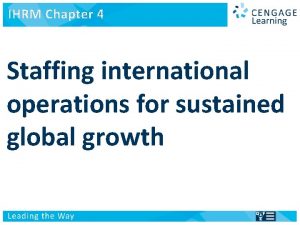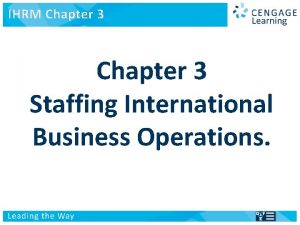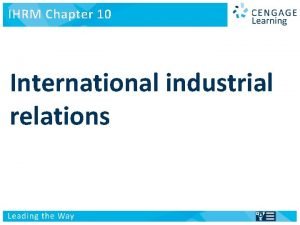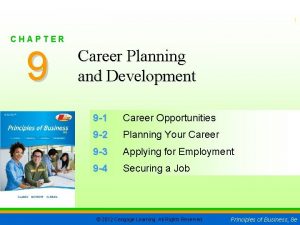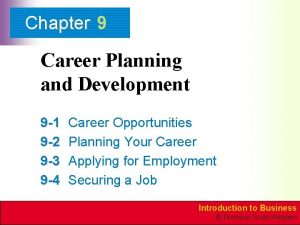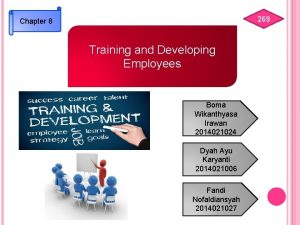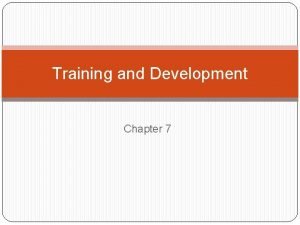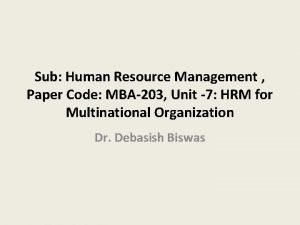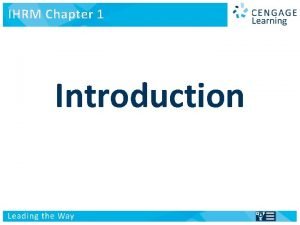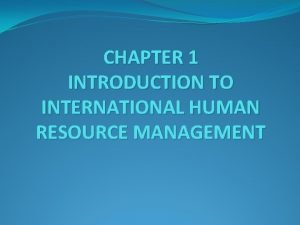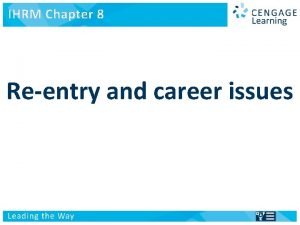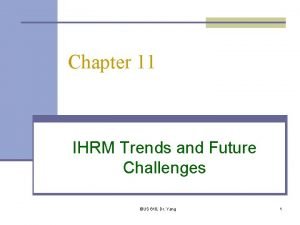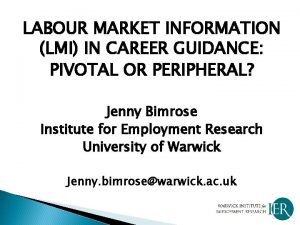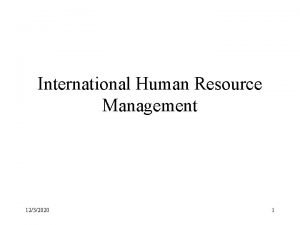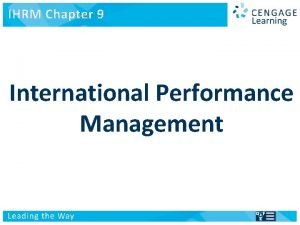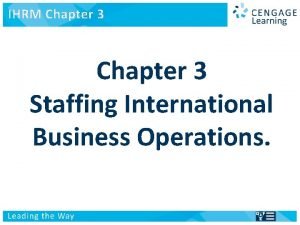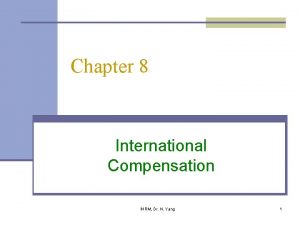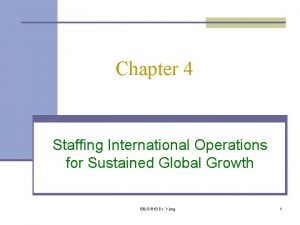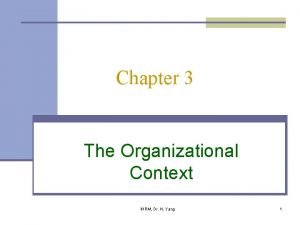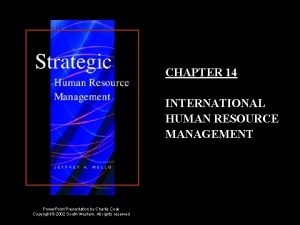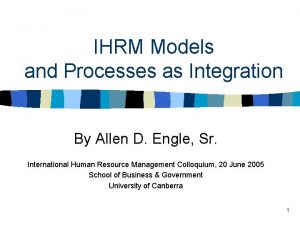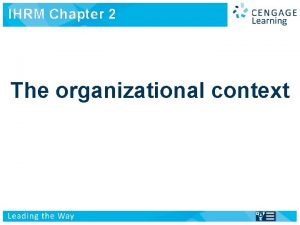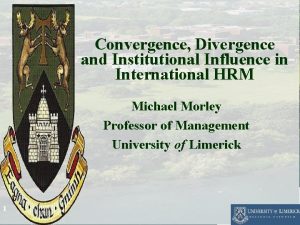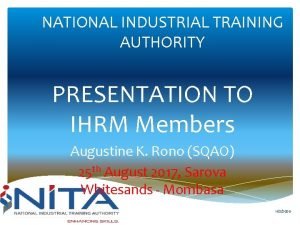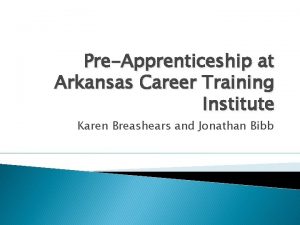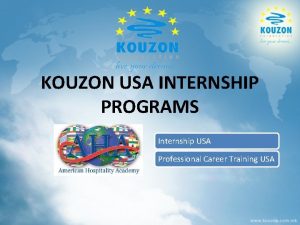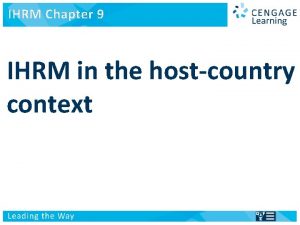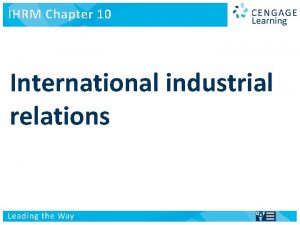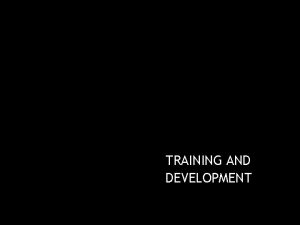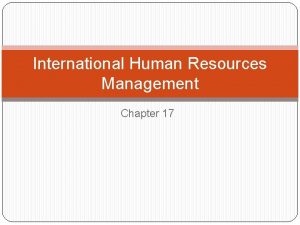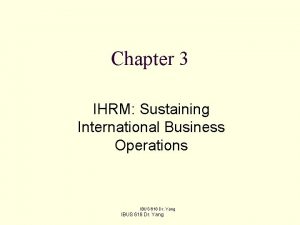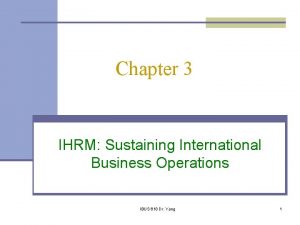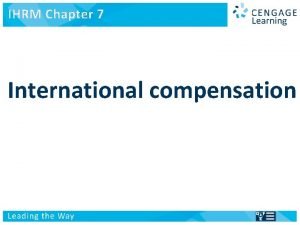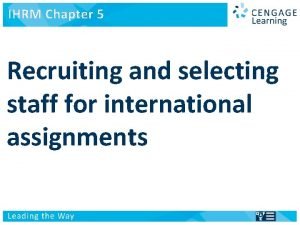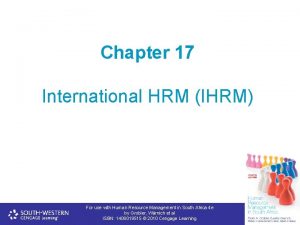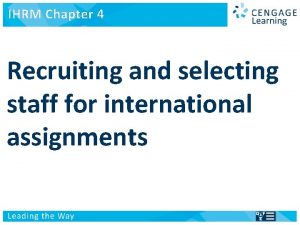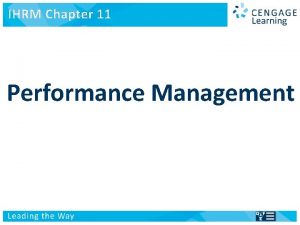Chapter 7 International Training Development and Career IHRM










































- Slides: 42

Chapter 7 International Training, Development and Career IHRM, Dr. N. Yang 1

Chapter Objectives n Define and contrast between training and development n Explore how the international assignment is a vehicle for both training and development, as reflected in the reasons why international assignments continue to play a strategic role in international business operations n Examine the role of training in preparing and supporting personnel on international assignments n We examine the before, during, and post assignment issues: IHRM, Dr. N. Yang 2

Training and Development n Training aims to improve employees’ current work skills and behavior n Development aims to increase abilities in relation to some future positions or jobs. IHRM, Dr. N. Yang 3

International Assignments as a Training & Development Tool n Expatriates are trainers Part of knowledge & competence transfer Expected to help train & develop HCNs n Expatriate ensure adoptions Show systems and procedures work Monitor performance of HCNs n A form of management development Job rotation to gain a broader perspective Assist in developing a pool of capable global operators IHRM, Dr. N. Yang 4

Figure 7. 1 International training and development IHRM Chapter 6 IHRM, Dr. N. Yang 5 5

Pre-departure Training Programs n U. S. MNCs were found reluctant to provide predeparture training n n n U. S. firms 32% European firms 69% Japan 57% n GMAC-GRS 2004 n 62% firms provided at least a 1 -day training n 74% made it optional n Most firms include family: n Primary reason: n Top managers saw it as not necessary or effective n No time n n IHRM, Dr. N. Yang Whole family 28% Spouse 27% Employee only 5% None 40% 6

Table 7. 1 Availability of cross-cultural training in MNEs Brookfield 2009 Brookfield 2011 CCT available 81% 74% CCT attendance optional 78% 75% § Employees only 7% 4% § Employee and spouse 32% 46% § Whole family 56% 49% IHRM Chapter 6 IHRM, Dr. N. Yang 7 7

Components of Pre-departure Training n n n n Cultural awareness programs Preliminary visits Language training Practical assistance Security briefings Training for the training role TCN and HCN expatriate training Non-traditional assignments and training IHRM, Dr. N. Yang 8

Black & Mendenhall’s Three Key Dimensions for Cross-cultural Training q Training methods q Levels of training rigor q Duration of training, relative to Expected degree of interaction n Culture novelty – how different host culture is from native culture n IHRM, Dr. N. Yang 9

Information-giving approach Low interaction, similar cultures Length of training < 1 week CCT methods emphasize an information-giving approach: n n Area or cultural briefings Lectures, movies, books Interpreters ‘Survival-level’ language training IHRM, Dr. N. Yang 10

Affective approach 2 -12 month assignment, some interaction More training rigor 1 -4 + weeks long CCT methods emphasize an affective approach: n n n Role-playing Critical incidents Culture assimilator training Case studies Stress reduction training Moderate language training IHRM, Dr. N. Yang 11

Immersion approach High interaction, novel culture More training rigor 2+ months long CCT methods emphasize an immersion approach: n n n Assessment center Field experiences Simulations Sensitivity training Intercultural web-based workshop Extensive language training IHRM, Dr. N. Yang 12

Degree of Cultural novelty The Mendenhall, Dunbar and Oddou Cross-cultural Training Model Degree of Interaction with HCNs IHRM, Dr. N. Yang 13 13

Figure 6 -3 Cultural awareness training and assignment performance IHRM Chapter 6 IHRM, Dr. N. Yang 14 14

Table 7. 2 Perceived value of cross-cultural preparation of expatriates Value Rating Brookfield 2011 Brookfield 2009 Of great value 25% 19% Of high value 64% 60% Of medium value 11% 19% Of little value 0% 2% Source: Brookfield Global Relocation Trends 2009 and 2011, LLC. IHRM Chapter 6 IHRM, Dr. N. Yang 15 15

Developing Staff through International Assignments n Management development n Organizational development n Individual development n PNNs, HCNs, TCNs n Non-traditional expatriate assignments n International business travelers n Overcome time and resource constraints IHRM, Dr. N. Yang 16

Expected Outcomes of International Assignments n Management development n n Individuals get experience, advance careers MNE gets cadre of experienced international operators n Organizational development n n n MNE accumulates knowledge, abilities MNE & individuals develop a global mindset MNE gets direct control & socialization, which assist the transfer of knowledge and competence IHRM, Dr. N. Yang 17

Networked MNEs’ Benefits from International Teams n A mechanism for fostering innovation, organizational n n learning, knowledge transfer A means of breaking down functional & national boundaries, enhancing information flows A method for encouraging diverse decision-making, problem-solving, and strategic assessments An opportunity for developing a global perspective A technique for developing shared values; thus helping MNE with informal, normative control through socialization IHRM, Dr. N. Yang 18

Figure 7. 2 Developing international teams through international assignments IHRM Chapter 6 IHRM, Dr. N. Yang 19 19

Trends in internationals training and development n Convergence for T&D from the pressure of globalization n Divergence with growing realization of the importance of the national context n Host-countries pressure for localization of T&D initiatives n Increasing awareness of NGOs’ importance n The rise of China and T&D focused on China Motorola University, Siemens Business School, European Management Institution, HP Business School, Hairer University, IBM Research Labor, Ericsson China R&D Institute CPA tests, ETS exams The U. S. 100, 000 Strong Educational Exchange Initiatives, May 2010 n Realizing the need to address global, comparative, and national contexts for effective T&D programs IHRM, Dr. N. Yang 20

Figure 7. 3 Expatriation includes repatriation IHRM, Dr. N. Yang 21

Figure 7. 4 Repatriation activities and practices IHRM, Dr. N. Yang 22

IHRM in Action 7. 1 Repatriation and loss prevention at ISCAM n Wayne Bullova took an international assignment for n n three years as Loss Prevention and Safety Director at ISCAM’s new regional center in central Peru. ISCAM did a good job to prepare him and his family for the difference between Lima and Denver. His wife enjoyed local life, and his children quickly adjusted to the American school in Peru. Wayne immediately enjoyed the increased responsibility and centrality of his new role. He returned to a very different world upon repatriation. IHRM, Dr. N. Yang 23

IHRM in Action 7. 1 Repatriation and loss prevention at ISCAM n The corporate restructuring occurred a year into his expatriate n n assignment. His long-time mentor and friend Herman Balkin took reportedly a generous early retirement package. His network dissolved, with a series of junior new executives. He spent the better part of a month trying to get an office and to understand his new job. The counter-terrorism and security protocols he developed in Peru were either ignored or modified by his supervisors. Wayne placed his children in a city school district that the children were having problems with, and his wife started to complain about Denver’s winter. After taking a 5 -week vacation he was due, Wayne wrote up a letter of resignation. What went wrong? Could that be prevented? IHRM, Dr. N. Yang 24

The Repatriation Process n Assign home sponsors or mentors n Home leaves, work-related information exchanges, and pre-departure orientation process n After return orientation to the new job assignment and local work group n Reconnection to local social network, assisting and coping with factors that drive postassignment family and career anxieties IHRM, Dr. N. Yang 25

Expatriate Turnover (GMAC-GRS 2011) n Expatriate average annual turnover 8% n During assignment 22% n Within 1 yr. of return 28% n Between 1 -2 yrs. of return 24% n Over 2 yrs. 26% IHRM, Dr. N. Yang 26

International Assignment Failure GMAC-GRS 2011 n n Brookfield 2010 Failure rate 4% Leading causes n n n Premature return 7% n Leading causes n Spouse/partner dissatisfaction 18% Poor candidate choice 16% Poor job performance 13% Inability to adapt 12% Other family concerns 8% n n n Spouse/partner dissatisfaction 65% Other family concerns 47% Poor candidate selection 39% IHRM, Dr. N. Yang 27

Effectiveness of Ways to Reduce Expatriate Turnover (GMAC-GRS 2011) In order of high, medium, or low effectiveness: § Opportunity to use experience 35% § Position choices upon return § Recognition 22% 16% § Repatriation career support 13% § Improved performance evaluation 9% IHRM, Dr. N. Yang 28

Individual Reactions to Re-entry n Job related factors n Social factors n Personal and organizational outcomes IHRM, Dr. N. Yang 29

Figure 7. 5 Factors influencing repatriate adjustment IHRM, Dr. N. Yang 30

Table 7. 3 Career impacts of international assignments IHRM, Dr. N. Yang 31

Language Training n The role of English as the language of world business n Host country-language skills and adjustment n Knowledge of the corporate language IHRM, Dr. N. Yang 32

The Impact of Language on Power IHRM, Dr. N. Yang 33

Shadow Structure Based on Language IHRM, Dr. N. Yang 34

Responses by the MNE n Staff availability and career expectations § Boundaryless and protean careers § International itinerants n Return on investment (ROI) § Direct and indirect costs § Using TCNs and HCNs as a way to reduce costs n Knowledge transfer § Identifying critical, implicitly held knowledge assets inherent in expatriation-repatriation § Reducing resistance and building trust IHRM, Dr. N. Yang 35

Figure 7. 6 Linking repatriation process to outcomes IHRM, Dr. N. Yang 36

Knowledge & Skills Acquired from International Assignment n Market specific knowledge – Local systems (political, social, economic), language, customs n Personal skills – Inter-cultural knowledge, selfconfidence, flexibility, tolerance n Job-related management skills – Communication, project management, problem-solving Network knowledge – Meeting diverse people n General management capacity – An enlarged job description, broader job responsibilities, exposure to n other parts of the organization IHRM, Dr. N. Yang 37

Table 7. 4 Topics covered by a repatriation program IHRM, Dr. N. Yang 38

Proactive Strategies for Smooth Re-entry n Pre-departure briefings on what to expect during the assignment & upon return n Multiple career planning sessions n Written repatriate agreements clarifying available assignments upon return n Mentoring programs that continue after return n Extended home visits to keep up with social, family, & organizational changes n Reorientation programs on changes in organization n Personalized orientation on emotionally-charged issues n Personalized reorientation on financial & tax advice n Providing an adjustment period upon return n Visible and concrete expressions of the repatriate’s value to the firm IHRM, Dr. N. Yang 39

Summary n T&D through international assignments n CCT components and effectiveness n The importance of language training n ROI and knowledge transfer n Key issues through the expatriation- repatriation process n Trends and proactive strategies in managing international assignments, expatriate retention, and careers IHRM, Dr. N. Yang 40

Vocabulary n n n n T&D = training & development, the human resource, NGOs internal hires cultural awareness training, CCT, field experiences, degree of expected interaction, cultural novelty or similarity information-giving, affective, & immersion approaches, security briefings role-playing preliminary visit Additional types of training: international cadre § Language multinational, virtual teams § Critical incidents repatriation, ROI § Culture assimilator reverse culture shock mentors, repatriation program § Stress reduction career anxiety, work adjustment § Simulations family adjustment, social networks § Sensitivity boundaryless careers, protean careers international itinerants IHRM, Dr. N. Yang 41

Discussion Questions 1. What are some of the challenges faced in training expatriate managers? 2. Assume you are the HR director for a small company that has begun to use international assignments. You are considering using an external consulting firm to provide pre-departure training for employees, as you do not have the resources to provide this ‘in-house’. What components will you need covered? How will you measure the effectiveness of the pre-departure training program provided by this external consultant? 3. How does an international assignment assist in developing a ‘cadre’ of international operators? Why is it necessary to have such a ‘cadre’? 4. Why do some MNEs appear reluctant to provide basic pre-departure training? IHRM Chapter 6 IHRM, Dr. N. Yang 42 42
 Training and development in ihrm ppt
Training and development in ihrm ppt Ihrm training and development
Ihrm training and development Determinants of staffing choices
Determinants of staffing choices Virtual assignment in ihrm
Virtual assignment in ihrm International industrial relations in ihrm
International industrial relations in ihrm Chapter 9 career planning and development
Chapter 9 career planning and development Chapter 9 career planning and development
Chapter 9 career planning and development Chapter 9 career planning and development
Chapter 9 career planning and development 16 national career clusters
16 national career clusters Formulas for career success career testing & investigation
Formulas for career success career testing & investigation Chapter 8 training and developing employees
Chapter 8 training and developing employees Method of training
Method of training Difference between hrm and hrd
Difference between hrm and hrd International or multinational
International or multinational Difference between domestic hrm and ihrm
Difference between domestic hrm and ihrm Ihrm trends and future challenges
Ihrm trends and future challenges Introduction to ihrm
Introduction to ihrm Expatriation and repatriation in ihrm
Expatriation and repatriation in ihrm Ihrm trends and future challenges
Ihrm trends and future challenges Education and training career cluster definition
Education and training career cluster definition Career opportunities in biotechnology and drug development
Career opportunities in biotechnology and drug development Super's career development theory pros and cons
Super's career development theory pros and cons Ocr level 6 diploma in career guidance and development
Ocr level 6 diploma in career guidance and development Chapter 6 career readiness review
Chapter 6 career readiness review Definition of personnel management
Definition of personnel management Performance management for expatriates
Performance management for expatriates Role of non-expatriates in ihrm
Role of non-expatriates in ihrm Expatriate compensation worksheet
Expatriate compensation worksheet Role of non-expatriates in ihrm
Role of non-expatriates in ihrm Organizational context of ihrm
Organizational context of ihrm The cultural context of ihrm
The cultural context of ihrm Strategic hr issues in international assignments
Strategic hr issues in international assignments Asymmetric events in ihrm
Asymmetric events in ihrm Repatriation process in ihrm
Repatriation process in ihrm Ihrm models
Ihrm models The importance of human resource management
The importance of human resource management Management demands of international growth
Management demands of international growth Convergence vs divergence hrm
Convergence vs divergence hrm Ihrm membership list
Ihrm membership list Arkansas career training institute
Arkansas career training institute Kouzon
Kouzon Career guidance training
Career guidance training Blueprint career development
Blueprint career development
